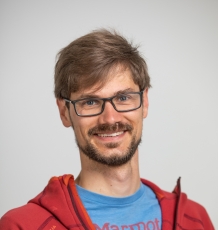
Dr Stefan Harmansa
Senior Research Fellow
S.Harmansa@exeter.ac.uk
2402
Living Systems Institute T02.09
Living Systems Institute, University of Exeter, Stocker Road, Exeter, EX4 4QD
Overview
Morphomechanics – Shaping Growing Tissues
Morphogenesis delineates the complex process of shape generation during embryonic development. Morphogenesis is an intrinsically mechanical process where cellular activities, like contractility or growth, lead to stresses that mechanically mould tissues into their complex 3D shapes. Proper morphology is essential for organ functionality and defects in morphogenesis are linked to developmental disorders and disease.
I am particularly interested in the interplay between growing epithelial tissues and their basement membranes (BMs), specialised sheet-like extracellular matrices. Like the foundation of a building, BMs acts as base for epithelial cells and their mechanical properties (such as stiffness) as well as their growth properties directly influence cell and tissue morphology. I recently demonstrated that differential growth between a tissue and its BM leads to the accumulation of growth-induced mechanical stresses that guide tissue morphology (Harmansa et.al. 2023). Using a combination of Drosophila genetics, advanced imaging techniques, quantitative biophysical tools and data-informed modelling my group aims to uncover how such stresses arise during tissue growth and how they guide the mechanics of morphogenesis.
We are a newly established group that officially joined LSI in February 2024 and will be supported by a Wellcome Career Development Award. For more details on our current research, news and open positions please visit our group’s webpage.
Principal Investigator Profile
Stefan studied Biology at the University of Basel, Switzerland. He then joined the team of Prof. Markus Affolter at the Biozentrum in Basel for his PhD work, studying organ size control during animal development. For his postdoctoral work he joined the team of Prof. Thomas Lecuit (Institute of Developmental Biology in Marseille, France) investigating how growth-induced stresses shape epithelial tissues. His work identified an essential role for the growth orientation of the extracellular matrix in determining 3-dimensional morphology during organ growth.
In February 2024 he joined the Living Systems Institute in Exeter (UK) as a group leader, investigating the biomechanical interplay between growing tissues and their basement membranes.
Qualifications
Degrees
2010 BSc, Integrative Biology, University of Basel (Switzerland)
2011 MSc, Molecular Biology, University of Basel (Switzerland)
2016 PhD (Hons., summa cum laude), Developmental Biology, University of Basel (Switzerland)
Awards
2023 – Career Development Award of the Wellcome Trust
2022 – Prize of the Fondation Hugot of the Collège de France
2019 – CENTURI Postdoctoral Fellow
2017 – EMBO Long-Term Fellow
2015 – J.C.W. Shepherd Prize of the Biozentrum Basel
Career
Since 2024 Group leader at the Living Systems Institute, Bioscience, University of Exeter, UK
2017-2023 Postdoctoral Research Fellow with Prof. Thomas Lecuit, Institute of Developmental Biology Marseille (IBDM), Marseille, France
2011-2016 PhD student in Developmental Biology (Group of Prof. Markus Affolter), Biozentrum, University of Basel, Switzerland
Links
Research group links
Research
Research interests
Basement Membranes in Shape Generation
Organ shape emerges during morphogenesis, a mechanical process whereby forces exert stresses leading to cell and tissue deformation that shape growing tissues. The shaping of growing tissues depends on genetic cellular programs that biochemically and mechanically interact with the extracellular environment. In particular the extracellular matrix, a complex network of macromolecules surrounding the cells instructively guides morphogenesis.
We use the fruit fly Drosophila melanogaster to investigate how the Basement Membrane, a specialized extracellular matrix covering epithelial tissues, mechanically interacts with and thereby shapes the morphology of growing tissues. Basement Membranes (BM) are sheet-like extracellular matrices rich in Collagen IV. They cover the basal side of epithelial tissues, the major building blocks of our internal organs. Basement membranes provide physical support for tissues and their mechanical properties directly feed back on tissue morphology. We want to understand how growing tissues mechanically interact with their basement membranes and how this interaction is guiding changes in tissue shape.
Depending on their biophysical properties and dynamics growth patterns, basement membranes can act as geometric boundary and hinder the expansion of growing tissues. In particular, differences in growth dynamics can lead to the accumulation of residual stress which leads to cell and tissue-scale deformations. Using and interdisciplinary approach, we aim to uncover how such stresses emerge, with the ultimate goal to actively control such stresses and thereby guide custom tissue morphologies.



